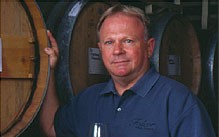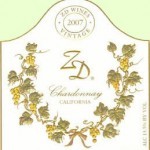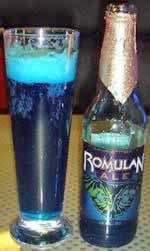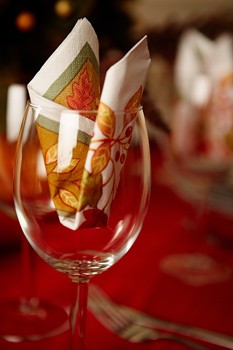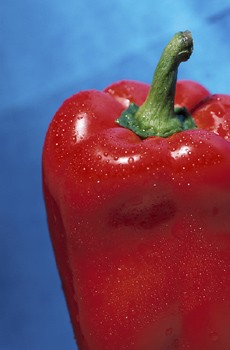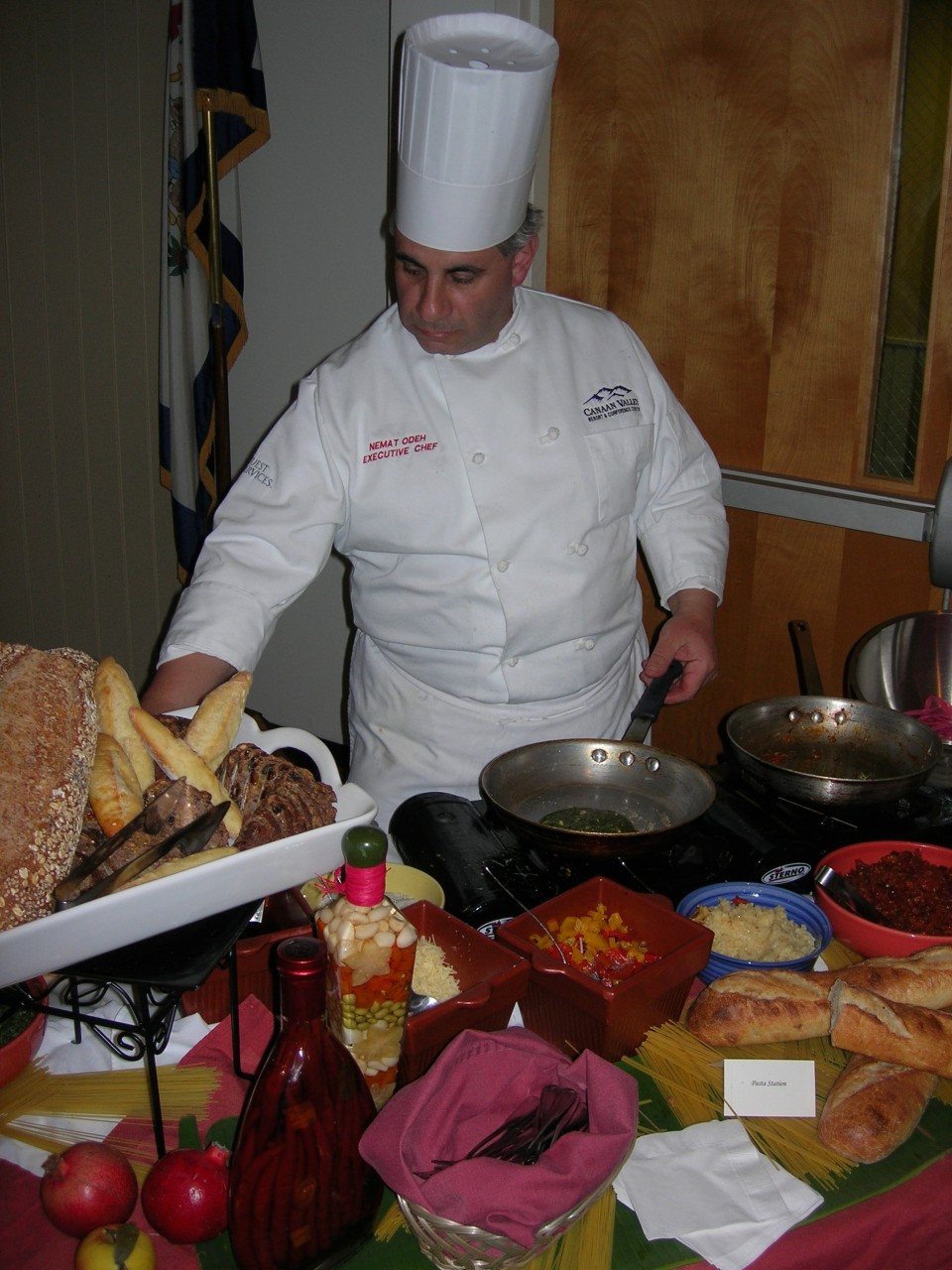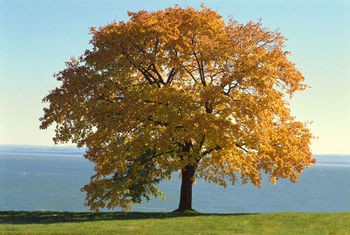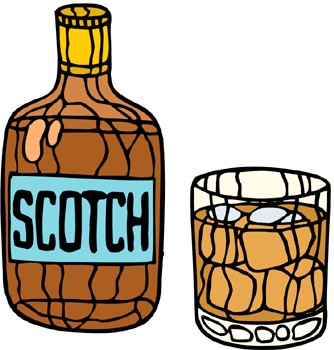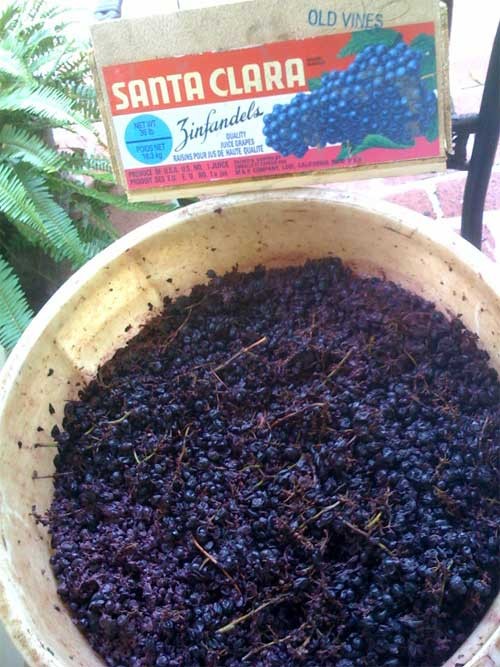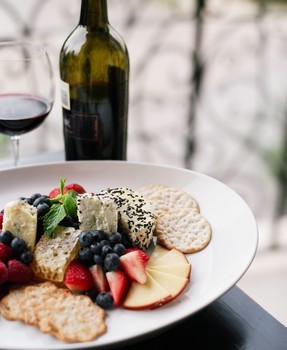It’s not often many of us can have our dreams come true, but that’s pretty much the case for two Charleston lawyers whose love of wine has morphed from a passionate hobby to another full-time occupation.
John Brown has been a wine and food columnist in West Virginia since the 1980’s. His regular columns appear in the Charleston (WV) Gazette-Mail under the title Vines & Vittles.
I have to admit, I have been very critical in recent years about how certain winemakers, usually from
California, vinify perhaps the greatest of all white wines - chardonnay. In a word, too many chardonnays are “overdone.”
How? Well, some chardonnay growers allow the grapes to get overripe on the vine which produces not only hot, high alcohol wines, but also ones that lack balancing acidity. Then, many of these same wines are put in new wood barrels and allowed to absorb huge amounts of oak flavors, completely overwhelming the fruit and producing a wine that doesn’t even resemble something that once actually grew on a vine.
What you’re left with is a beverage that’s about as subtle as “White Lightnin' ” without the benefit of corn liquor’s kick! And forget about matching the stuff with food unless your tastes run to dishes like anaconda and habanero casserole.Now, I am not the first wine writer to criticize chardonnay made in this bombastic manner, but I may be one of the first to complain about the knee-jerk response to this style by other wine makers. I refer to them as the ascetic school of chardonnay producers.
These guys have ridden the pendulum to the other extreme, making some of the most austere, acidic and painfully bland chardonnay in a pitiful attempt to capitalize on the criticism with the overblown stuff.
Help! Is there anyone out there who can restore sanity and a sense of balance to producing this absolutely wonderful wine???
Just when you’re ready to give up on ever enjoying a chardonnay that actually reaches it’s enormous potential….bam, pow wee.. you taste something that renews your faith in the unpredictability of wine.
So there I was in a restaurant called Frank’s at Pawley’s Island, escaping from the brutal frigidity of
Charleston to bask in the near temperate climes of North Cack-a-lacky when, to my lips, I placed a glass of chardonnay.
Hoakey Smokes! The stuff was subtle, creamy, rich yet balanced, and tasted like the fruit of a grape called… chardonnay! And no, this was not a $200 bottle of white Burgundy or even some trophy wine from Napa. It is the 2007 ZD (California) Chardonnay.
At about $25 a bottle, the wine has a “California” appellation, meaning that the grapes for it could have come from anywhere in the state – not necessarily a prime location like Carneros or Santa Rita Hills, Napa or Sonoma.
I drank the wine with grilled grouper and the combination was a testament to the old axiom about the whole being greater than the sum of the parts. What a superb match.
Lest I be misunderstood, I would not describe the wine as great. It is just very good and very true to the varietal grape – chardonnay – from which it was made. However, in producing a wine that is the purest essence of chardonnay, ZD deserves kudos.
Here are some other wineries that seem to produce balanced chardonnay year in and year out: Chateau Monelena; Talley Vineyards; Acacia; Pine Ridge; Montes Alpha; Merryvale Starmont; and Alamos.
Go get you some!
When the ambient air temperature descends below 40 degrees Fahrenheit, I seem to require foods and beverages of substance. Stews, soups, roasted meats and full flavored cheeses, such as Roquefort and Stilton, grace the table in my humble abode this time of year.
To accompany these hearty foods, I usually uncork full-bodied wines such as zinfandel, syrah or cabernet sauvignon and, to cap the meal off in style, a glass or two of Port with coffee, nuts or cheeses. While I have written about the glories of Port for you in this space before, it is winter and it just seems an appropriate time for me to visit this tasteful subject again.While our per capita consumption of table wine in this country has increased to a respectable level, the volume of Port (or any dessert wine for that matter) consumed in this nation is so small it could fit on a gnat’s eyelash!
In fact, most of us have an aversion to any sweet wine because of either (a) bad personal experiences, or (b) prejudicial views passed on down to us by uninformed know-it-alls who assert that “only dipsomaniacs or effete snobs drink Port.”
I’m still trying to forget the night (a few decades ago) I spent hovering over the “porcelain alter” after consuming an inordinate quantity of a sweet, high alcohol rocket fuel some low-rent winery had the nerve to call Port. I’m sure some of you have had similar experiences and have vowed never to let the vile stuff pass your lips again. And you shouldn’t!
But let me suggest that classifying Port and high alcohol, sweet wine as one and the same is like believing turpentine and chardonnay (both of which are white liquids having alcohol as a component) are also the same.
Port or Porto (as it is called in Portugal where it is produced) can be made from a variety of (unpronounceable) red grapes grown along the steep slopes of the Douro River. The river flows toward the town of Oporto where the wine is sold to shipping companies who age it, label it under their house name and then export it all over the world.
Port is fortified which means that brandy is added to the fermenting wine. This causes the fermentation to stop, leaving about 10 percent residual sugar in the wine and also boosting the alcohol to about 20 percent. While Port was produced in a mainly dry style for centuries, today’s sweet version was popularized by the British in the middle of the 18th century. Many Shippers are also British companies.
Since there are several styles of Port, here is a description of the most common types:
Vintage Port -This is the best and most expensive style and is produced in only about three years a decade. A “vintage year” is usually declared by an agreement among the shippers and the wines are given special care and aging. Once you buy it, vintage Port can age easily for 15 to 25 years before reaching full maturity. Recent vintage Port years are 1983, 1986, 1991 and 1992, 1994, 1997, 2000 and 2003.
Late Bottled Vintage Port - Not to be confused with vintage Port, this wine is a blend of Ports from different vineyards in the same vintage year. Late Bottled Vintage Port (or LBV) will have a vintage date on the label, but is not vintage Port. However, this wine is vinified in the same manner as vintage Port, except it is aged in barrel longer to accelerate their drinkablity.
Ruby Port - Young Port wine blends from several different vintages comprise Ruby Port. They are lighter and fruitier than other styles and usually the least expensive Ports.
There is no doubt that we are in a serious economic downturn, and I often ruminate on how these tough times are affecting the wine industry as well as those of us for whom the fruit of the vine is more than just an occasional dalliance.
I suppose there is both good news as well as bad in how the economic crisis is affecting wineries around the globe. The law of supply and demand has always been a major fact of life in the wine world. When a bad vintage limits supply, prices go up and, conversely, an overabundance of wine drives prices down.
Looking for way to pull yourself out of the post-holiday blues? How about some reds…or whites… or some top-notch victuals. Well, listen-up buckaroos because there are some nice wine-related events on the radar screen for the greater Charleston area that should help you beat those winter blues.
Good food and wine always seem to lift my spirits and shine some much needed light on my seasonal affective disorder. The following event lineup is sure to brighten your smile this winter too.
Welcome to 2009 wine lovers! Today, I’m taking the pledge! Not to go to the gym or to lose 10 pounds, or to (heaven forbid) limit my consumption of adult beverages.
No siree, I’m resolving to go where no wino has gone before. To explore new galaxies of wine appreciation, to set a course for bacchanalian bliss and to sip the most obscure Romulan elixir! [ED. NOTE: I added at right a shot of some Romulan ale, but don't you think that's Rich Ireland's bailiwick?]. So, get on board, loosen up and be prepared to toss wine convention to the wind.
It’s beginning to look a lot like Christmas. I can tell because many of the people I know are calling asking me to suggest a wine gift or two for the special people in their lives. Even though I probably won’t be considered “special” enough to benefit from my own advice, I do experience a kind vicarious enjoyment in being a part of this process.
So today, I’ll share with you some gifts I would love to have this holiday season, and hope that you will pass these ideas along to my family and friends. Of course, depending upon your bank account, you can spend just about as much as you choose on wine and related gifts. However, my budget is not unlimited so we’ll stick with gifts you may acquire for under $100.
As we get closer to the holidays, I’ve become hopelessly nostalgic and, yes, even maudlin. Why? Well, suffice it to say that I yearn for the company of a certain group of friends who’ve left my immediate circle. And while I will be surrounded by family and other friends this Christmas, I truly miss these special ones that have gone away.
Some of you may remember the WineBoy Webcast that appeared on this site last year. Alas, the show was cancelled after one glorious season. That’s sad enough, but the loss I feel most is for those five intrepid experts who appeared with me from time to time to present their unique views on wine appreciation.
I speak, of course, of wine astrologist Marcrazi Umberto Lupini, the Right Reverend Red N. White, English nobleman and wine critic Sir Reginald Winesot Clydesdale, Frenchman Pierre N’Cest Pas (wine cynic and American wine hater) and cowboy oenophile Spud Dumplin.
More...So today, I’ll lift a glass to these unique individuals who, in the past, have provided me with inspiration, advice and, from time to time, a welcome dose of reality as I attempted to impart a little wine information on the webcast. Here are some special holiday wishes and my gifts to these very wise men.
To wine astrologist Marcrazi Umberto Lupini: May your Christmas be filled with galaxies of shooting stars, a cornucopia of moonbeams, urns of anchovies, and only the most fragrant garlands of garlic and tripe. For you Umberto, I send a special CD “The Vatican’s Greatest Hits” performed by such musical luminaries as Aldo Cella, Lucca Brazzi and Treccy Bungunga (with liner notes by Father Guido Sarducci).
To the (always) Right Reverend Red N. White: As your preaching reaches a fever pitch this holiday season, I wish you voluminous lung capacity, hordes of cowering congregants and a bevy of beautiful women sitting in the front row (at least ones without facial hair). Your gift, Reverened, will be a Methuselah of Sparky’s Heavenly Elixer and Altar Wine along with 200 new reptile boxes to fit under the pews.
To Sir Reginald Winesot Clydesdale: May your stables be always muck free, may your upper lip be always stiff and may your trademark whinny and neigh resonate thunderously through the midlands. For you, dear Reginald, I am sending one dozen designer clip-on ascots to conceal your rather prominent (but distinguished) goiter.
To Pierre N’Cest Pas: My dear Pierre, I hope your holidays are filled with flagons of wine (French, of course), long-legged Pariesan women and the songs of Pepe LePew. I’m sending you a DVD of the movie “Bottle Shock” which memorializes the 1976 Paris blind tasting where an American wine was selected by Frenchmen over a first- growth Bordeaux. Mon Dieu!
To cowboy oenophile Spud Dumplin: May you always ride under cloudless skies, may your wine bottles be full and corkless, and may your domestic animals always be well groomed and obedient. Spud, my friend, I am mailing you a copy of Arsenius the Hermit’s famous book: “If Only Sheep Could Cook.”
Odd n’ ends…As you know, each year around the 15th of November, the first wine of the 2008 vintage from the Beaujolais region in France is released to the public with great fanfare and celebration.That’s right, Beaujolais Nouveau time is upon us and this year’s wine is very good.
In terms of drinkability, Beaujolais Nouveau can be a lively, frothy, strawberry fruit- forward mouthful of wine. At its best, the wine is a pleasant quaffer that is never meant to be taken too seriously, but rather to be enjoyed and celebrated. Even when the wine is ordinary, it’s still something I look forward to each year.
When I was growing up, one of our faithful family traditions involved enthusiastic discourse around the holiday dinner table. To the rare outsiders who were infrequently invited to our large family repasts, the decibel level of this “enthusiasm” must have been a bit disconcerting. No subject was too grand, obscure or off limits. We would debate everything from presidential elections to the color of Aunt Agnes’ moustache, and those who prevailed usually did so through din rather than eloquence. So, in keeping with family tradition, my brother and I have debated for decades the best wines to pair with Thanksgiving dinner. After exhaustive and sometimes heated discussions, we have come to the conclusion that almost every wine can marry nicely with some part of the Turkey Day meal. Why? Listen up. For years, I have written about the culinary versatility of turkey to be successfully paired with white or red, as well as light or full-bodied wines. The reason is this bird is blessed with meat that has different flavors, colors and textures. Add to this the way it is cooked - from traditional oven-baking, to deep frying, to grilling, to smoking (with hardwood such as apple) - and you have even more wine choices from which to select. When you add stuffing to the turkey, you add a whole other flavor dimension which, depending upon the nature of the dressing, opens up even more wine possibilities. One year, for example, I stuffed a charcoal grilled turkey with cornbread, ancho chili peppers and chorizo sausage. What wine, you might ask, did I serve with this non-traditional turkey and stuffing? Well, I started with Domaine Carneros sparkling wine as an aperitif. I proceeded to open a bottle of Pierre Sparr Pinot Gris for those who preferred white wine, and a Ridge Lytton Springs Zinfandel for those who wanted a big red. And guess what? It worked. For dessert, I chose a bottle of Joseph Phelps Late Harvest riesling to accompany the pumpkin pie, and then plopped on the couch to watch some team beat up on the Detroit Lions.Here are a few wine-pairing suggestions, based upon cooking methods, for your Thanksgiving Day: The traditional oven-roasted turkey with a mild dressing is very nicely accompanied by whites such as pinot grigo, sauvignon blanc or chardonnay, or reds such as pinot noir, chianti classico, or sangiovese. Older wines such as Bordeaux or California cabernet sauvignon go nicely as well. On the other hand, if you smoke or grill your bird, try full-bodied zinfandel, shiraz, Chateauneuf Du Pape or even Amarone. So what about my approach this year? Well, I plan to stuff the critter with bread dressing flavored with Italian sausage, chestnuts, onion and celery, then bake it in the oven. With this traditional meal, I’ll start with a bottle of Vigna Dogarina Extra Dry Prosecco ($23, at right) for the aperitif, followed by 2007 Baron Fini Pinot Grigio ($14) as well as 2005 Falcor Sangiovese ($35) (which will both be poured with the main course). For dessert with pumpkin pie, I’ll be blowing my diet with a taste of 2004 Arrowood Late Harvest Riesling ($24). Since Aunt Agnes shaved her moustache, the only thing left to decide is the subject of the family holiday dinner debate. Bon Apetit!
Since my days as a long distance runner are in the rear view mirror, I have had to find a suitable aerobic exercise regimen to forestall the dirigible-like expansion of my midsection. I am fighting the inevitable losing battle. However, I am persistent and so I work out feverishly on exercise equipment, sweating profusely so that I can rationalize a lifestyle that only Orson Welles might have considered moderate.
I feel compelled to mention this because, as you can probably guess, I spend a considerable amount of time thinking about food and wine. And today, I am going to provide you with a recipe that is so delicious you won’t mind working out just so you can justify having it on a regular basis.
Someone once said that necessity is the mother of invention and so, as I rummaged around in the pantry and refrigerator looking for culinary inspiration, I stumbled upon a few ingredients and came up with a delicious meal idea. I call it Smoky Salmon Pasta.
The shopping list:
One red bell pepperOne-half cup of chopped cilantro
One clove of chopped garlicThree tablespoons of extra virgin olive oil
One chopped jalapeno pepper
One-half cup dry white wine
One-quarter cup of Half-and-Half
One cup of chicken broth
Oone-quarter pound of smoked salmon
One pound of farfalle pasta (bow-ties);
(Salmon Note) You may use any smoked salmon that is readily available, but I prefer to get mine from Joe’s Fish Market in Charleston (304-342-7827). The good folks at Joe’s brine and then “cold smoke" their salmon over apple wood and it is fabulous. It’s also great as an appetizer with a good pinot noir, such as the 2006 Evesham Wood from Oregon.
Preparing the meal:
1. Put a fork in the red pepper and roast it over the burner on the stove turning it until the skin begins to blacken. Place the pepper in a small paper bag and allow to sit for about 20 minutes. Then peel it, discard the seeds and chop into half inch pieces.
2. In a large sauté pan, place olive oil, jalapeno and garlic and lightly cook until the veggies are soft. Then add the chicken broth white wine and cook on moderate heat until liquid is reduced by one-third. Remove the pan from the burner and add the red pepper and salmon.
3. Now boil the farfalle in salted water until al dente (about 10 minutes). Place the sauté pan back on the burner, add the pasta, the half and half, season with salt and pepper and toss all ingredients. Now add the cilantro and serve.
Wine Recommendations:This meal needs a full-bodied white wine. I love it with the Falcor Chardonnay which is a rich, oaky mouthful of wine that marries nicely with the spicy, smoky flavors of the dish. You might also try the L’Ecole No. 41 Semillon from Washington State which is ripe and round with good balancing acidity.
Chef Odeh doing his thing at last year's gourmet wine and food weekend
Canaan Valley Resort is planning a “Gourmet Wine Weekend in the Mountains," and I’ll be there to help spread the joy!
Join me and other wine and food lovers on November 14-16 for an entertaining and educational gourmet extravaganza. I’ll select wines from around the world that will be paired with a cornucopia of culinary delicacies prepared by Canaan Valley Resort’s classically trained European executive chef, Nemat Odeh
And the good news is you will have the option of attending the entire weekend, or choosing to participate in individual events ala carte.
The Schedule of Events:
-Fri., Nov. 14, 7 p.m. - A “taste-around reception” where more than 20 wines from the world’s most prestigious regions can be sampled with matching culinary treats, including crab cakes, beef tenderloin, smoked salmon, pasta, a raw bar and other treats.
-Sat. Nov. 15, 11 a.m. – I will conduct an educational wine tasting and seminar where guests will taste and evaluate a number of wines from around the world along with matching cheeses.
-Sat. 12 noon - The tasting will be followed by a delicious three- course luncheon with specially selected wines.
-Sat. 6 p.m. - An aperitif reception featuring a selection of wines to prepare the palate for the multi-course Grand Gourmet Dinner which will follow.
-Sat. 7 p.m. – Chef Odeh is planning an autumn-inspired five-course menu with accompanying wines, featuring Continental cuisine and using only the freshest seasonal ingredients. I will match his goodies with some truly outstanding wines.
For information on pricing or to make a reservation, you may call 800-622-4121 or visit online at:www.canaanresort.com.
This past week we celebrated the life of a true American hero who braved the high seas to make sure we all have a place to call home. I refer, of course, to Christopher Columbus. As we toast Columbus this week with pasta and flagons of Chianti, you need to know the truth about our intrepid hero and how history was shaped by his love of good wine and food.
Columbus is most commonly thought of as a great explorer, but in reality he was an exceptional pitch man who was desperately trying to get someone to bankroll his questionable idea to find a shorter route to India where he would procure all manner of exotic spices.
Let’s also be honest and admit that as a sailor he was, at best, directionally challenged. Here’s a guy who traveled west to find a quicker route to the east and ended up discovering North…. America.
But Columbus was an unrelenting salesman who spent most of his life trying to convince the powers that be (back then) to underwrite his voyage. In Italy, he threw party after banquet after bacchanalian feast trying to secure the funds.
As a result of this constant feasting, Columbus became a great gourmand who whose prodigious appetite for food and wine was legendary. He was also a major pain in the rear for the Italian officials who were constantly bombarded with his proposals.
Finally, he went too far. After suggesting that you could get from Rome to Venice by way of the Caspian Sea, his Italian countrymen banished him to the loony bin, but not before for he had consumed an entire wheel of gorgonzola and washed it down with copious quantities of Frascati.
Undaunted, Columbus then went to Portugal where he lobbied King Ferdinand and Queen Isabella. At the conclusion of a six-day orgy, where barrels of Italian wine were consumed with the finest Portuguese cuisine, the king and queen agreed, secretly hoping with all their hearts that he would sail out of their lives and off the end of the world.
The rest, is as they say, history!
You may question the veracity of my story, but if you’ve ever been to Italy, you know the Italians, like Christopher Columbus, take their wine and their food seriously. I do too, and that’s why I think the vast portfolio of Italian wines suit just about every cuisine imaginable.
Unfortunately, most Americans think Italian wines should only be served with Italian foods, particularly the old stand-by of spaghetti in a red sauce. Well, yes, a good barbera (from northern Italy) does pair nicely with this type of pasta, but so does zinfandel, syrah and petite syrah – wines not native to Italy.
Today, I hope to convince you to try the wines of Italy and use them with the foods you eat each day. Italy has been described as a boot full of wine and there is no doubt this ancient and venerable land of friendly people and great food is awash in a sea of white and red. From the Piedmont in the northwest to the island of Sicily in the south, each of Italy’s 20 states makes more wines themselves that most countries produce.
And Italy boasts some of the greatest red wines in the world such as barolo and barbaresco produced in Piedmont from the nebbiolo grape. You will certainly need to decant these wines for hours before drinking and then you will need a full-bodied roasted meat dish, such as venison, to accompany them.
In Tuscany, Brunello Di Montalcino is also considered a great red wine. While the aforementioned barolo and barbaresco are heavy wines, brunello is more subtle, silky and mroe approachable in its youth. Try it with grilled lamb seasoned with rosemary, garlic, olive oil and lemon.
Everyone has heard of chianti ( a region in Tuscany), but did you know that there is chianti, chianti classico (a delimited area where the best wine is produced) and also chianti classico riserva (which requires the chianti classico to be aged in oak barrels for a specified period of time). Chianti is made from a combination of grapes, the most prominent of which is sangiovese. Chianti’s go well with roasted and grilled foods like chicken, salmon and portobello mushrooms.
In the northeastern part of the country, pinot grigio and prosecco are the most famous white wines, while chardonnay, cortese di gavi, arneis and gewurztraminer are also produced in the same geographic region. Try the chardonnay with pasta in creme and butter sauces, the prosecco as an aperitif and the pinot grigio with lighter dishes such as omelets or quiches.
Another superb white wine is made from a grape called vernaccia. Try a Vernaccia Di San Gimignano from Tuscany for a lovely treat that is a nice accompaniment to broiled seafood such as sole or sea bass. Many other whites, such as frascati, soave, and orvieto, are generally lighter styled wines and can be used as aperitifs or with salads, seafood and vegetable casseroles.
I‘ve barely scratched the surface in telling you about the wines of Italy. Wines such as amarone, the full-bodied red of the Veneto, aglianico from Campania, primitivo from Apulia or nero d’avola from Sicily are also readily available for your sipping pleasure and can be matched with a wide variety of foods you consume each day.
So, the next time you reach for that bottle of cabernet to accompany your grilled beef tenderloin, grab a bottle of merlot from northern Italy or a nice vino nobile di Montepulciano from Tuscany instead. Salute!
There's something exhilarating about Fall. Mother Nature is dishing up the colors, colleges are playing football and wineries (in this hemisphere, at least) are harvesting grapes and making wine. I love this time of year. I am amped, and I have been taking action!
In the last month alone, I have: roasted two bushes of sweet red peppers, crushed 1,000 pounds of grapes, grilled all manner of fish, fowl and cow and consumed enough food and wine to insure an ample supply of blubber to get me through the winter.
And, dear friends, I have been toiling mightily at the alter of Bacchus -- just for you. This fine Fall day, I have a slew of tasteful recommendations for your consideration. These little lovelies hail from all over the globe, and are very reasonably priced. I hope you'll give some a try and let me know what you think by posting a comment.
My good friend and fellow Gazz blogger Rich Ireland is always touting the compatibility of beer with food, and I have to agree there are some pretty interesting brew and grub combos. But for those of you out there who occasionally sip beverages other than the fruit of the vine, you might be interested in a rather unique sipping and supping event featuring some pretty unusual food and beverage pairings. How about full course gourmet meal accompanied by……Scotch? Well, listen up.
Bridge Road Bistro in Charleston and Boathouse Bistro in Morgantown will hold Scotch and related spirits tasting dinners in October. A Scotch master will join guests at the Charleston restaurant Thursday, Oct. 2, and at the Morgantown restaurant Thursday, Oct. 16, as they enjoy a spirited dinner with an appetizer-to-dessert menu that features the Scotch they’ll be drinking. In Charleston, the Scotch tasting will feature The MacCallan Scotch and in Morgantown, the featured Scotch will be The Balvenie.
For the first time in more than 30 years of wine making, WineBoy has been able to acquire old vine zinfandel for his home winemaking.
I've been a busy WineBoy lately! The annual harvest ritual at the Brown household is officially underway. This past Saturday, I picked up 22 lugs (36-pound wooden boxes) of old vine zinfandel grapes from the St. Albans Kroger store where I had ordered them a few weeks ago. These purple lovelies, transported cross country in a refrigerated vehicle, hail from the Lodi (California) American Viticultural Area (AVA) just south of Sacramento.
I'm pretty excited because this is the first time, in more than 30 years of wine making, that I have been able to acquire old vine zinfandel. The good folks at Kroger have been sourcing grapes for local wine-obsessed amateurs like me for decades. Over that period of time, I have used a number of different varietals to make wine, including cabernet sauvignon and cabernet franc, merlot, syrah, petit sirah, grenache, sangiovese and regular ( young vine) zinfandel. Until this year, however, I was never able to acquire old vine zinfandel.
Look, I know I've always preached that wine appreciation is a very subjective undertaking, and that you should drink whatever you want, with or without food. I still feel that way. Yet you may have noticed that most of my wine recommendations also come with a suggested food pairing. That's because I feel strongly that food brings out the best in wine - and vice-versa.
Washington State is a geographically schizophrenic state, a land of extremes with two distinct personalities. Seattle, situated along Puget Sound with the Cascade Mountains to the east and the Olympic range to the west, is more known for its annual precipitation than its well-deserved reputation as one of the most livable cities in the world.
The other Washington begins once you cross Snoqualmie Pass in the Cascade Mountains, just 54 miles east of Seattle. The lush, green Alpine landscape suddenly gives way to beige and brown hues as you travel east away from the Cascades along Interstate 90.
One of the most unique individuals I've ever met, Kay Dillon, is proprietor of Okay's at 222 Leon Sullivan Way in Charleston. Kay is not only one of the most informed bar-keeps I've ever encountered, she is also a trained psychologist (which I feel should be a pre-requisite for tending bar), caring mother, devotee of music and all the arts, and just an all around wonderful lady.
Okay's is more than just a bar. It is a state of mind and a little oasis where you can whet your whistle, engage in some great conversation or just sit at the bar and watch Miss Kay flit from table to bar, to table greeting, hugging, serving, schmoozing and generally doing what only she can do at a pace which is at once dizzying and bewildering.
In the short time she has been associated with Okay's (and the predessor business, Blues Barbecue), Kay has served the most comprehensive variety of beers of any place I've visited in this state. And her wine selections are both eclectic and well thought out with an emphasis on quality and value. Oh, by the way, her pizza is excellent too!
Unfortunately, Okay's is in peril of closing. Through a series of personal misfortunes Kay has experienced in recent months, Okay's is in dire need of your immediate patronage if the establishment is to survive. I hope all my readers and friends will come in to Okay's soon, belly up to the bar, drink in the atmosphere (she has live music too), sip a beer or glass of wine and have some really good food.
Our town needs Okay's!
____________________EVENT: Bridge Road Bistro Wine Dinner, Aug. 25, 2008Those of you who enjoy the culinary artistry of Chef Paco Aceves of the Bridge Road Bistro and the lovely wines produced by locally-owned Napa Valley winery – Falcor – are in for a treat.
A special multi-course dinner with accompanying wines from Falcor will be held on Monday, Aug. 25 at 6 p.m. Ryan Bee, assistant wine maker at Falcor, will provide commentary on the wines. Check out the menu below:

